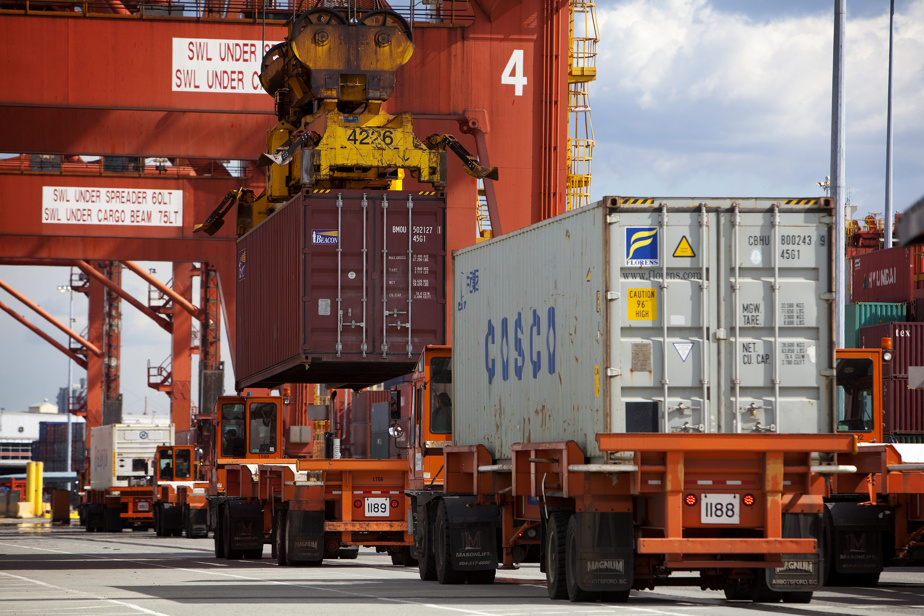Grocery stores: the specter of toilet paper
A rush for toilet paper rolls, empty shelves: the bad memories of the pandemic could well have come back to haunt consumers if the conflict had lasted beyond a few days. Retailers and specialists had predicted price increases and shortages of certain products. In this context, Pascal Leduc, president of Leduc Stratégie et conseil en gestion commerciale, also expected a reduction in promotions. And the “legitimate concern” of consumers hoarding supplies would have contributed to creating shortages, he maintains.

PHOTO MARTIN CHAMBERLAND, LA PRESSE ARCHIVES
Ultimately, food costs were at risk of exploding due to the rail conflict.
“Rail transportation is a fundamental component of Canadian supply chains,” he explains. “We transport basic commodities, manufacturing inputs and finished products.”
According to him, there was “no chance that truck transport could compensate for this volume of deliveries, in the short or medium term.”
Michel Rochette, Quebec president of the Retail Council of Canada (RCC), also feared that prices would rise rapidly if there were no regulation. Trucking, which would have become the alternative solution, would not have been enough to meet demand. And costs would have exploded.
Long wait for a fridge
David Larivière, executive vice-president of Germain Larivière stores, assures that he has enough items in stock. But quickly, the supply of household appliances from Asia could have become problematic. These are normally delivered by train from Vancouver. Organizing transport by truck would have inevitably caused delays, according to him.
In the event of a prolonged work stoppage, Mr. Larivière recommended that customers, particularly those who need to buy new appliances to replace those damaged by the recent floods, order their household appliances in advance.
Furniture manufacturing could also have become complex, he points out, since some parts also come from Asia and are delivered to the Port of Vancouver. Production of recliners and mattresses, for example, would have been affected in the long term.
The rush for trucks
Jean-Denis Toupin, CEO of the metal construction specialist Groupe Proco, was one of the entrepreneurs who were keeping their fingers crossed that the impasse would be resolved quickly.
Like many companies, this specialist in metal constructions – which notably manufactures bridge beams for the Quebec Ministry of Transport – based in Saint-Nazaire is dependent on rail transport to supply its steel plates.
“Trucking still works, but it’s longer and more expensive, it’s a lot of transportation to manage,” explains Mr. Toupin. “Plus, there’s not an unlimited number of drivers and trucks.”
The proof: at the Lafrance Group, a Montreal specialist in transport and logistics, the telephone was already ringing more and certain limits on the capacity to absorb additional requests were already looming on the horizon.
“My number of truckers who can go to Ontario and the West is limited,” says company president Daniel Bineau. “This forces us to work on a first-come, first-served basis.”
Overflowing ports
They could have adapted for a while, but Canadian ports would have ended up being overloaded because of a prolonged paralysis at the Canadian National Railway Company (CN) and Canadian Pacific Kansas City (CPKC).

PHOTO PATRICK SANFAÇON, LA PRESSE ARCHIVES
The Port of Montreal
The Port of Montreal is an intermodal hub: nearly 45% of the goods – particularly containers – that transit there are destined for one of the two major Canadian railways.
So it was necessary to take measures to avoid being cramped on the docks. This is what the Montreal Gateway Terminals Corporation – which operates two of the port’s three international terminals – did in the last week, since signs pointed to a labour dispute in the railway industry.
“We’ve shipped as much as we can to the railways over the last seven days,” says its president and CEO, Michael Fratianni. “We still have space right now to accommodate containers for trucks. I’m not saying we’ll have it for several weeks.”
The United States, collateral victim
Much has been made of the potential repercussions of a protracted dispute in the rail industry, but our neighbours to the south were also tapping their feet. American carriers, such as CSX and Norfolk Southern, had put the brakes on shipments crossing the Canada-U.S. border every day.
As a sign of the importance of being able to travel on both sides of the border, Jim Vena, CEO of Union Pacific, the largest American railway company in terms of revenue (US$24 billion in 2023), personally contacted the federal Minister of Labour, Steven MacKinnon, earlier this week.
The contents of his letter, which The Press was able to consult: a Canadian conflict would have effects as far as the United States.
“Nearly one-third of Canadian railroad volumes cross the border, impacting Union Pacific and its customers,” Vena wrote. “I want to reiterate that it is imperative that you take action to prevent a work stoppage.”
The testimonies were collected by The Press as supply chain stakeholders put contingency plans in place due to the paralysis at CN and CPKC.
